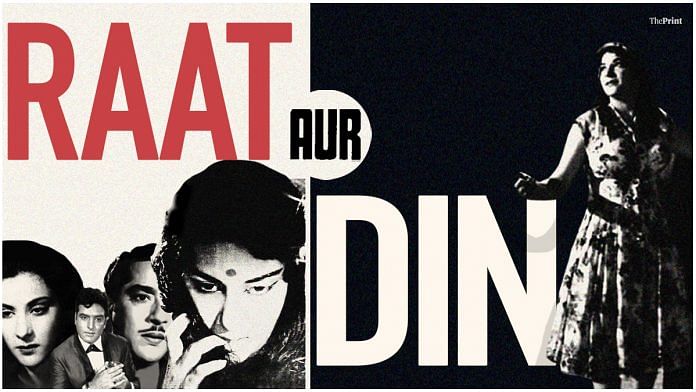When one thinks of Nargis Dutt’s film career, one usually thinks of Mother India or of her famous pairing with Raj Kapoor, seen in movies like Aag, Awara, Barsaat and Shree 420. These were big movies, made when Nargis was at her peak.
But if there is one movie that truly showcases her talent and her ability to be different people, even in one scene, it is Raat Aur Din. The 1967 movie directed by Satyen Bose and produced by Jaffer Hussain, Nargis’ brother, had actually gone on the floors in 1960, but a shortage of funds meant the project had to be stalled for a few years. By then, Nargis had married actor Sunil Dutt and quit films (apart from one scene in her husband’s movie, Yaadein, in 1964) to settle into happy domesticity as a mother of three.
It was only for her brother’s sake, and only for this movie, that she came back to the screen, so this was her comeback as well as her swansong. And it could not have been a more fitting one. Nargis even won the first National Award for Best Actress for her performance in this movie.
In the week of Nargis Dutt’s death anniversary, here is a throwback to Raat Aur Din.
Also read: Amar Prem tells the story of relationships that have no name but the power to break hearts
Baruna by day, Peggy by night
The movie opens with Nargis in a slinky dress, her hair in a glamorous up-do, smoking a cigarette and hailing a cab to go to a club, where she sings and dances with abandon, and with a man named Dilip (Feroz Khan). Later, over whiskies and cigarettes, Dilip says they have met before, in Shimla. It’s not a pick-up line — they really had met in Shimla, but she insists she has never been to the hill town.
Because she has, unknown to everyone including herself, dissociative identity disorder. By day, she is Baruna, a quiet, docile, conservative homemaker, happily married to Pratap (Pradeep Kumar) and she did grow up in Shimla. But by night, she is Peggy, the hard-drinking, smoking, licentious flirt who wears tight dresses with high slits, sings and dances, much to the embarrassment of her husband and in-laws. And the next morning, she is Baruna again, who doesn’t remember any of these excesses and helplessly insists that she was in bed all night with a raging headache.
At the club, Peggy and Dilip are interrupted by an enraged Pratap, who has come to take his wife, Baruna, back home. The two men get into a fight, as Dilip believes Peggy who insists she isn’t married and has never seen Pratap before, but once they leave, he realises that Pratap was telling the truth.
What follows is how Baruna/Peggy’s personality disorder is diagnosed and the cause pieced together via flashbacks to her past. After her mother left her alcoholic, abusive, gambler father and moved with Baruna to Shimla, she kept the child isolated and locked up at home. A lonely Baruna secretly befriended her neighbour, a child named Peggy who loved to dance, and the two would meet behind her mother’s back. Years later, Baruna, by then a young woman, snuck out to Peggy’s Christmas party (which is where she met Dilip), and on her return, fought with her mother, who fell off a cliff and died.
Since then, Baruna has held herself guilty for her mother’s death, and in this trauma, developed a personality disorder.
Also read: An actor, mother, social worker – Nargis Dutt was far more than Mother India
Shanker-Jaikishan’s music had a starring role
As a psychological thriller or medical drama, Raat Aur Din isn’t terribly factual or nuanced. The scenes at the doctor’s clinic (Dr Dey’s Psycho Clinic, as it is called) are horribly caricaturish, with no authenticity in terms of the medical problem at hand, while Pratap’s mother (Leela Mishra) is reductively shown as a cruel mother-in-law who turns her pregnant daughter-in-law out into the streets on a rainy night. The obvious positioning of Baruna as day — the good woman, pure, surrounded by light — and Peggy as night — Western, devoid of good Indian values, in darkness — is also a problem.
But despite these flaws, it is a gripping story that’s beautifully shot in noirish black-and-white (itself a bold choice given that colour had long since come to Indian movies). And then there is the sheer luminosity of Nargis’ performance.
It’s a difficult tightrope to walk, between bold Peggy, who flirts with doctors and demands they give her liquor, and traditional-minded Baruna, who is ashamed of herself after every such incident. But Nargis manages the delicate balance between the two with grace, helped along by Shanker-Jaikishan’s gorgeous melodies, with lyrics by Shailendra and Hasrat Jaipuri.
In fact, the soundtrack of Raat Aur Din also does a great job of balancing Baruna’s melancholy with Peggy’s joie de vivre. The subtly sad title song, as well as Jeena Humko Raas Na Aaye are lovely, the latter particularly heartbreaking in its rawness. But the real standout is Awara Ae Mere Dil, which appears twice — once at Peggy’s Christmas party, where it is a happy number about freedom, and once after Baruna/Peggy has received shock therapy and she sings, “Raat aur din ke yeh do chehre kab tak pehnoon?” (Till when do I have to wear these two faces, of night and day?)







It was a nice movie with fabulous songs.